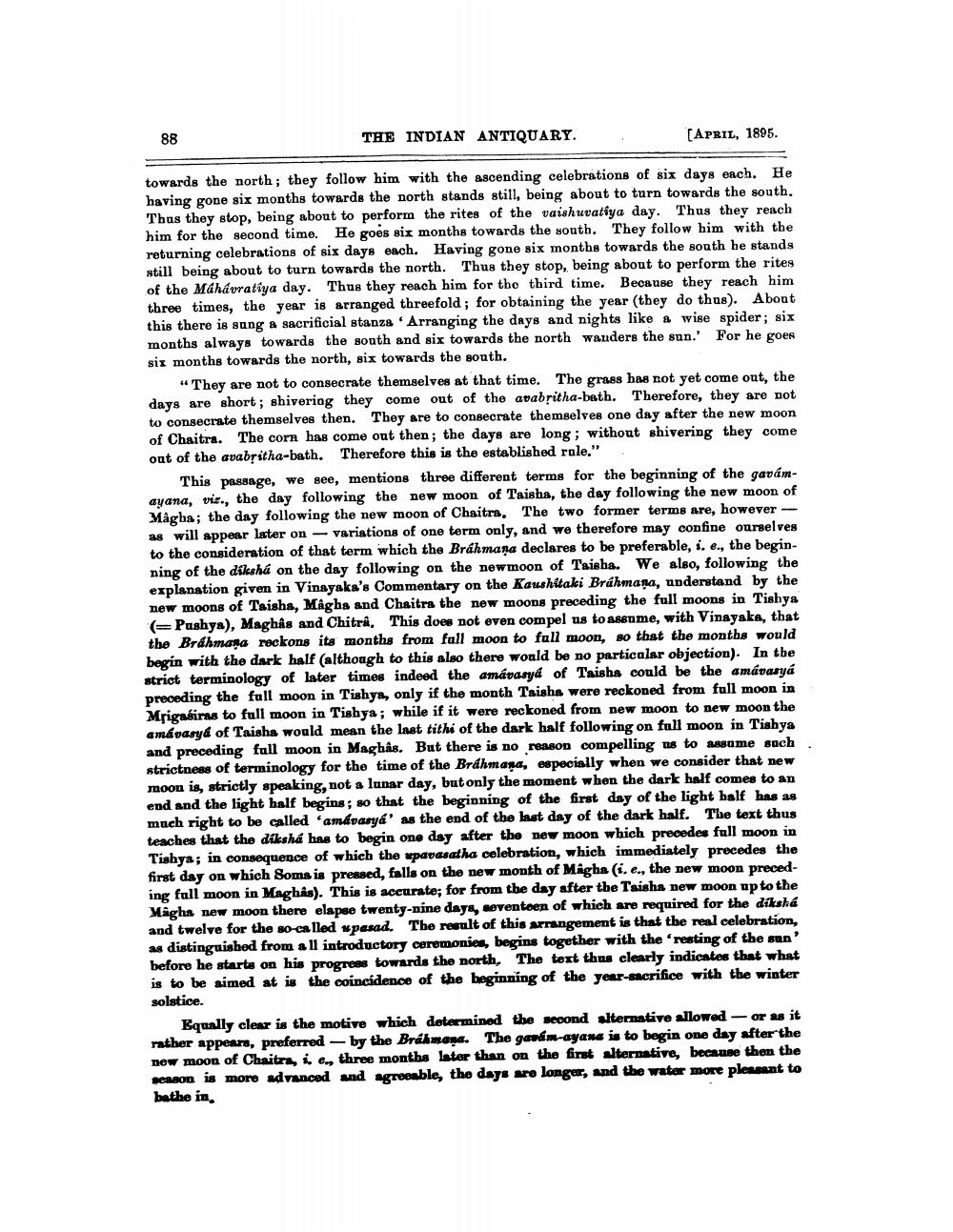________________
THE INDIAN ANTIQUARY.
[APRIL, 1895.
towards the north; they follow him with the ascending celebrations of six days each. He having gone six months towards the north stands still, being about to turn towards the south. Thus they stop, being about to perform the rites of the vaishuvatiya day. Thus they reach him for the second time. He goes six months towards the south. They follow him with the returning celebrations of six days each. Having gone six months towards the south he stands still being about to turn towards the north. Thus they stop, being about to perform the rites of the Mahávratiya day. Thus they reach him for the third time. Because they reach him three times, the year is arranged threefold; for obtaining the year (they do thus). About this there is sang a sacrificial stanza Arranging the days and nights like a wise spider; six months always towards the south and six towards the north wanders the sun.' For he goes six months towards the north, six towards the south.
“They are not to consecrate themselves at that time. The grass has not yet come out, the days are short; shivering they come out of the avabritha-beth. Therefore, they are not to consecrate themselves then. They are to consecrate themselves one day after the new moon of Chaitra. The corn has come out then; the days are long; without shivering they come out of the avabsitha-bath. Therefore this is the established role."
This passage, we see, mentions three different terms for the beginning of the gavámayana, viz., the day following the new moon of Taisha, the day following the new moon of Mâgha; the day following the new moon of Chaitra. The two former terms are, however as will appear later on - variations of one term only, and we therefore may confine ourselves to the consideration of that term which the Brahmana declares to be preferable, i. e., the beginning of the dikshá on the day following on the new moon of Taisha. We also, following the explanation given in Vinayaka's Commentary on the Kaushitaki Brahmana, understand by the new moons of Taisha, Magha and Chaitra the new moons preceding the full moons in Tishya (=Pashya), Maghâs and Chitra. This does not even compel us to assume, with Vinayaka, that the Brdhmana reckons its months from fall moon to full moon, so that the months would begin with the dark half (although to this also there would be no particolar objection). In the strict terminology of later times indeed the amavasya of Taisha could be the amavasya preceding the full moon in Tishya, only if the month Taisha were reckoned from full moon in Mrigasiras to full moon in Tishya; while if it were reckoned from new moon to new moon the amavasya of Taisha would mean the last tithi of the dark half following on full moon in Tishya and preceding full moon in Maghâs. But there is no reason compelling us to assume such strictness of terminology for the time of the Brahmana, especially when we consider that new moon is, strictly speaking, not a lunar day, but only the moment when the dark half comes to an end and the light half begins; so that the beginning of the first day of the light half has as mach right to be called 'amádasya' as the end of the last day of the dark half. The text thus teaches that the diksha has to begin one day after the new moon which precedes full moon in Tishya; in consequence of which the wpavasatha celebration, which immediately precedes the first day on which Soms is pressed, falls on the new month of Magha (i. e., the new moon preceding full moon in Maghas). This is accurate; for from the day after the T'aisha new moon up to the Magha new moon there elapse twenty-nine days, seventeen of which are required for the dikská and twelve for the so-called w pasad. The result of this arrangement is that the real celebration, as distinguished from all introductory ceremonies, begins together with the resting of the sun' before he starts on his progress towards the north, The text thus clearly indicates that what is to be aimed at is the coincidence of the beginning of the year-sacrifice with the winter solstice.
Equally clear is the motive which determined the second alternative allowed - or as it rather appears, preferred by the Brakmaņa. The ganám-ayana is to begin one day after the new moon of Chaitra, ie, three months later than on the first alternative, because then the season is more advanced and agreeable, the days are longer, and the water more pleasant to bathe in




